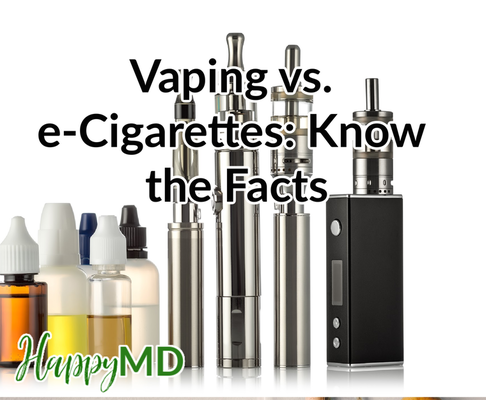
Explore the Differences - Vaping vs. e-Cigarettes
Vaping and electronic cigarettes (e-cigarettes or e-cigs) are very popular in today's society. While e-cigarettes have been on the market for nearly a decade and have grown increasingly popular over the years, the effects of these devices were not widely known and understood until recently. New evidence is just starting to emerge on the short-term effects of both vaping and e-cigs, along with information about their potential positive and negative impact on users' health. Here is an overview of e-cigarettes and vaping for those exploring these areas and/or who need clarification, so you know the facts.
How e-cigarettes operate and how they differ from vaping.
e-Cigarettes are battery-powered devices that heat an oil or a liquid solution housed within a cartridge. An e-cig cartridge contains a nicotine-based oil or liquid solution mixed with propylene glycol and glycerin. In many cases, the cartridge will also contain other flavorings, such as strawberry, bubble gum, peach, or vanilla, to make the inhalation experience more enjoyable and/or palatable. The e-cigarette also has a battery that heats the inserted cartridge and it converts the solution into a vapor that consumers can inhale. One of the advantages of this unit is that it provides nicotine,which is not only addictive but the negative health effects of this compound have been known for decades, for the consumer without the associated smoke. Yet, there is a vapor produced that must be expelled after inhalation, just like with a common cigarette. Due to the fact that smoke is not produced and the concentration of nicotine is much lower in e-cigs, they are generally considered to be a safer alternative to real cigarettes. Moreover, these devices have been shown to be an effective means to help smokers curb or quit their habit altogether. e-Cigarettes have also become quite popular among younger people and individuals who desire the positive effects attributed to smoking(e.g. stress relief, weight control, satiate oral fixation, etc.) without many of the associated health risks linked to smoking. Yet,there is still controversy over the use of e-cigs. Namely, the criticism is directed at smokers who use e-cigs in combination with traditional cigarettes, cigars, etc.Yet, there are other concerns about the long-term effects of these devices on users' health. Vaping, on the other hand, has some significant differences that new and prospective consumers should understand. While the delivery system is essentially the same, the contents of a vape cartridge can be very different from that of an e-cigarette. Namely, the use of a e-pen, which is very similar to the delivery mechanism for e-cigs, and the contents of the cartridges are more closely associated with pot products than an e-cigarette. This is an essential distinction to point out, especially for those who are exploring the benefits of e-cigs to help curb their smoking habit, along with those prospective patients who are researching the potential benefits and pitfalls of marijuana for medicinal purposes, especially where vaping is concerned. In vaping, ganja consumers must obtain an e-pen and cartridges, which contain their desired strain of cannabis in either liquid or oil form. Then, the patient loads the cartridge into the battery-powered device, which is known as a vape or e-pen, just like with an e-cigarette. The main difference is that pot cartridges do not contain any nicotine,so they are not addictive and are considered much safer than an e-cig and/or common cigarettes.
Here is a step-by-step overview of the vaping process:
1. You must fully charge your pen (MED-ePEN) before using it for the first use. Your pen comes with a USB charger that you screw onto the end. Plug the USB charger into a USB outlet on your computer or other device to charge it, or you can plug it into a wall charger. The light is red while charging. When the light turns green, the pen battery is fully charged and ready for use. Be careful not to overcharge the battery and keep in mind that it does not need to be charged daily. 2. Next, you need to assemble your pen for use. Start by unscrewing the cap and chamber from the pen battery. 3. Remove the rubber stopper from the end of the cartridge. 4. Screw the cartridge onto the pen battery. Be careful not to over tighten--tighten with fingers. 5. Replace the pen chamber to conceal the cartridge. 6. Click the power button 6 times to turn the pen on. A blue light should blink 3 times to confirm the pen is on and ready to go. 7. Hold the button and inhale for about 5 seconds. The blue light will appear while you are holding the button down and inhaling. The light will blink and turn off, however, if you inhale for more than 8 seconds. 8. Release the button and exhale the vapor. 9. You can take 1-3 puffs per session, if needed. Your certification, which also serves as your prescription, will specify how many doses a day are allowed. The maximum is typically 3-4 times daily. It is important to note that each puff should be 15-20 minutes apart during a session. 10. To turn your pen off, click the button 6 times and the light should blink 3 times to confirm itis off. Another crucial distinction between e-cigs and vaping is that medicinal cannabis patients are often not smokers. As such,many of the concerns and/or side effects attributed to e-cigarette users, who are often current or former smokers,do not necessarily apply to vapers. Some of the health effects associated with e-cigarettes include cancer, respiratory issues, higher risk of heart attack and stroke, pregnancy complications, and high blood pressure, just to name a few. The truth is, vaping and pot products are still burgeoning fields and the research is ever-evolving. The same is true of e-cigarettes. The long-term effects of both e-cigs and vaping are not known at this point. While potential health concerns are being raised about the effects of e-cigarettes, many of these issues do not apply to vapers,especially when dealing with ganja patients who are not current or former smokers. Only time will tell whether these concerns are justified. Hopefully, this article has proved a better understanding of vaping and e-cigarettes, so you know the facts and can make an informed decision. Patients can get a California medical marijuana card for high thc or cbd strains.
